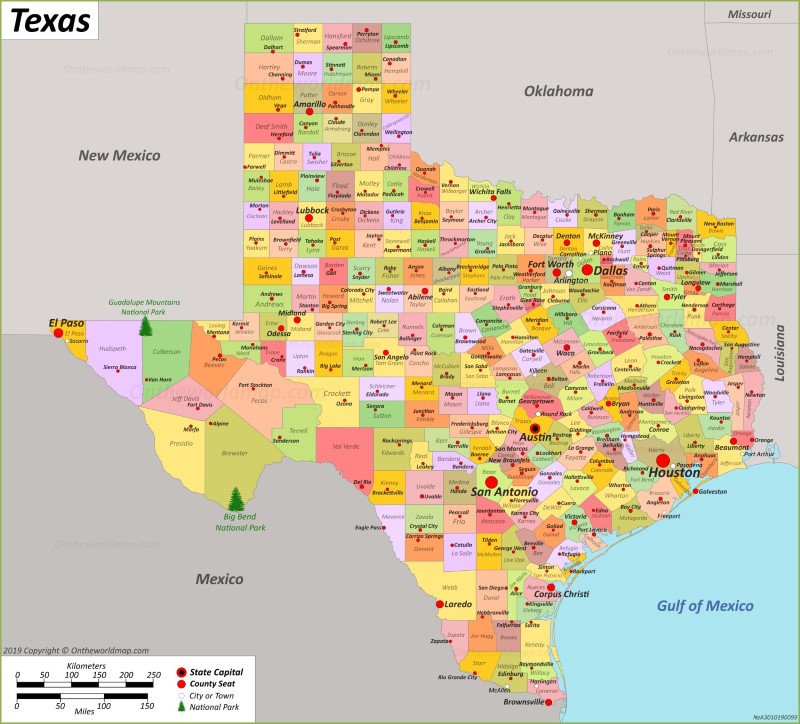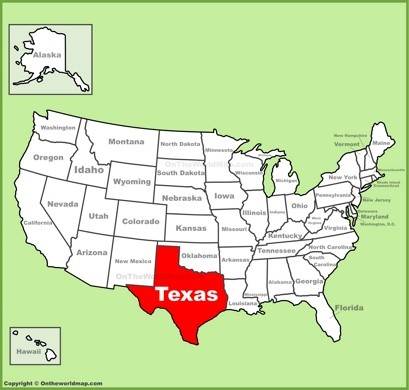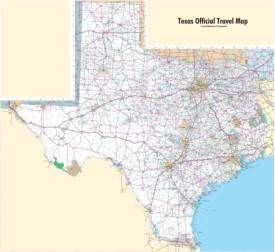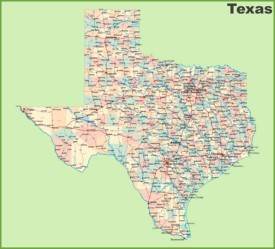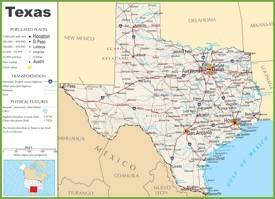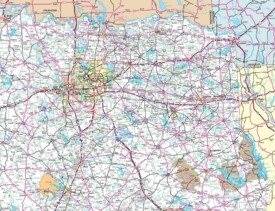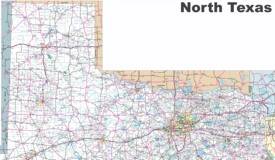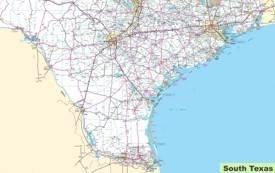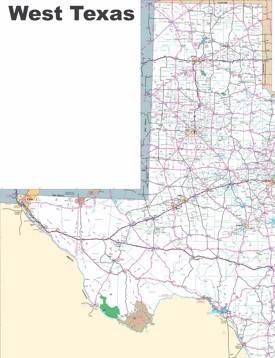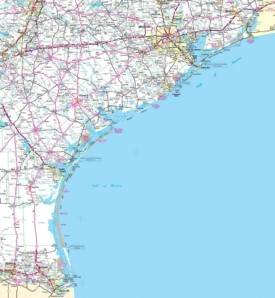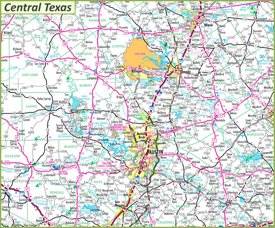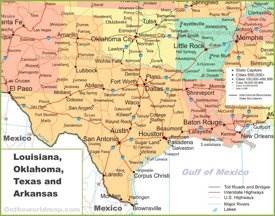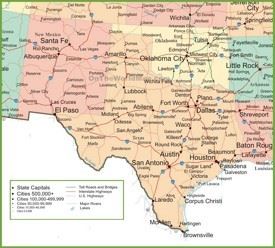Texas Map
Description:
This map shows boundaries of countries, states boundaries, the state capital, counties, county seats, cities, towns, Gulf of Mexico, islands and national parks in Texas.
Size: 2200x1990px / 1.52 Mb;
1800x1628px / 1.06 Mb;
1500x1357px / 411 Kb
Author: Ontheworldmap.com
You may download, print or use the above map for educational, personal and non-commercial purposes. Attribution is required. For any website, blog, scientific research or e-book, you must place a hyperlink (to this page) with an attribution next to the image used.
Page Navigation
Texas Location Map
Online Map of Texas
Detailed Maps of Texas
Maps of the regions of Texas
Maps of Texas and Neighbouring States
Other Maps of Texas
Google Map of TexasOpenStreetMap
Bing Maps
USGS National Map
Texas National Map (National Atlas of the United States)(pdf)
Texas Official Travel Map (pdf)
Texas Heritage Travel Guide Map (pdf)
About Texas
Texas lies in the south-central region of the United States. It shares borders with four U.S. states: Oklahoma to the north, Arkansas to the northeast, Louisiana to the east, and New Mexico to the west. International borders, especially with Mexico, run along the southwest and southern boundaries, demarcated primarily by the Rio Grande River. The Gulf of Mexico borders Texas to the southeast, providing significant coastline.
Austin, the capital of Texas, also serves as a major hub for technology and education, notably housing the University of Texas. Other principal cities include Houston, the state's largest city and a global energy center; San Antonio, known for its historical sites like the Alamo; and Dallas, a key commercial and cultural nucleus.
Tourists flock to Texas for a variety of attractions and resorts. The Gulf Coast, including cities like Galveston and Corpus Christi, offers beaches and maritime activities. The state also boasts significant historical sites, such as the San Antonio Missions National Historical Park. In Central Texas, the Texas Hill Country attracts visitors with its wineries, scenic landscapes, and recreational opportunities.
Major attractions include the Space Center Houston, a significant site for NASA operations, and Big Bend National Park, which offers extensive hiking and wildlife viewing opportunities. Overall, Texas combines urban, historical, and natural attractions, catering to diverse visitor interests.
The Facts:

Flag of Texas |

Seal of Texas |
| Capital: | Austin |
| Largest city: | Houston |
| Area: | 268,596 sq mi (695,662 sq km) |
| Dimensions: |
|
| Latitude: | 25°50′ N to 36°30′ N |
| Longitude: | 93°31′ W to 106°39′ W |
| Population (2023): | 30,503,301 [1] |
| Density: | 114/sq mi (42.9/sq km) |
| Elevation: | |
| Official language: |
|
| Spoken language:[3] |
|
| Religion (2020):[4] |
|
| Racial/ethnic groups (2020):[5] |
|
| Median household income (2022): | $66,963[6] |
| USPS abbreviation: | TX |
| ISO 3166 code: | US-TX |
| Time zone: |
|
| Official website: | www.texas.gov |
List of The Largest Cities in Texas by population
| Rank | City | County | Population (2022)[7] |
|---|---|---|---|
| 1 | Houston | Harris | 2,302,878 |
| 2 | San Antonio | Bexar | 1,472,909 |
| 3 | Dallas | Dallas | 1,299,544 |
| 4 | Austin | Travis | 974,447 |
| 5 | Fort Worth | Tarrant | 956,709 |
| 6 | El Paso | El Paso | 677,456 |
| 7 | Arlington | Tarrant | 394,602 |
| 8 | Corpus Christi | Nueces | 316,239 |
| 9 | Plano | Collin | 289,547 |
| 10 | Lubbock | Lubbock | 263,93 |
| 11 | Laredo | Webb | 256,187 |
| 12 | Irving | Dallas | 254,715 |
| 13 | Garland | Dallas | 240,854 |
| 14 | Frisco | Collin | 219,587 |
| 15 | McKinney | Collin | 207,507 |
| 16 | Grand Prairie | Dallas | 201,843 |
| 17 | Amarillo | Potter | 201,291 |
| 18 | Brownsville | Cameron | 189,382 |
| 19 | Killeen | Bell | 159,172 |
| 20 | Denton | Denton | 150,353 |
| 21 | Mesquite | Dallas | 147,899 |
| 22 | Pasadena | Harris | 147,662 |
| 23 | McAllen | Hidalgo | 144,579 |
| 24 | Waco | McLennan | 143,984 |
| 25 | Midland | Midland | 134,444 |
| 26 | Carrollton | Dallas | 133,82 |
| 27 | Lewisville | Denton | 131,215 |
| 28 | Abilene | Taylor | 127,385 |
| 29 | Pearland | Brazoria | 126,949 |
| 30 | Round Rock | Williamson | 126,697 |
| 31 | College Station | Brazos | 124,319 |
| 32 | Richardson | Dallas | 118,802 |
| 33 | League City | Galveston | 115,418 |
| 34 | Odessa | Ector | 112,906 |
| 35 | Beaumont | Jefferson | 112,089 |
| 36 | Allen | Collin | 111,551 |
| 37 | Sugar Land | Fort Bend | 109,414 |
| 38 | Tyler | Smith | 109,286 |
| 39 | New Braunfels | Comal | 104,707 |
| 40 | Edinburg | Hidalgo | 104,294 |
| 41 | Wichita Falls | Wichita | 102,664 |
| 42 | Conroe | Montgomery | 101,405 |
| 43 | San Angelo | Tom Green | 99,112 |
| 44 | Temple | Bell | 89,458 |
| 45 | Bryan | Brazos | 87,792 |
| 46 | Mission | Hidalgo | 86,635 |
| 47 | Georgetown | Williamson | 86,507 |
| 48 | Baytown | Harris | 84,324 |
| 49 | Longview | Gregg | 82,531 |
| 50 | Pharr | Hidalgo | 80,179 |
Main sights in Texas
- San Antonio's River Walk
- Space Center Houston
- The Alamo
- Texas State Capitol
- Sixth Floor Museum
- Fort Worth Stockyards
- USS Lexington
- Strand Historic District
- Big Bend National Park
- Guadalupe Mountains National Park
- Cadillac Ranch
- Padre Island National Seashore
Counties of Texas
Texas comprises 254 counties, the most of any U.S. state. These administrative subdivisions range widely in both population and geographical size. Harris County, which includes Houston, serves as the most populous, with millions of residents. Conversely, Loving County records the smallest population, often numbering just a few dozen individuals.
Geographical diversity characterizes Texas counties, from the arid landscapes of West Texas to the lush environments in the eastern Piney Woods region.
List of counties in TexasTexas County Map

Regions of Texas:
- Big Bend
- Blackland Prairies
- Brazos Valley
- Canadian River Valley
- Central Texas
- Concho Valley
- Coastal Bend
- Cross Timbers
- East Texas
- Edwards Plateau
- Gulf Coast
- Llano Estacado
- North Texas
- Northeast Texas
- Permian Basin
- Piney Woods
- Red River Valley
- Rio Grande Valley
- South Plains
- South Texas
- Southeast Texas
- Texas Hill Country
- Texas Panhandle
- Texas Urban Triangle
- Trans-Pecos
- West Texas
List of National Parks in Texas
Texas National Parks Map

State Parks in Texas
Geography of Texas
Texas, the second-largest state in the U.S., features a diverse geography that spans approximately 268,596 square miles. Its landscape ranges from arid deserts in the west to lush forests in the east. The state is commonly divided into four major regions: the Gulf Coastal Plains, the North Central Plains, the Great Plains, and the Basin and Range Province.
The Gulf Coastal Plains, including major cities like Houston, are characterized by flat lands, marshes, and extensive coastline along the Gulf of Mexico. Moving inland, the North Central Plains feature rolling hills and fertile soils, supporting cattle ranching and agriculture.
The Great Plains extend across the state’s central region, including the Texas Panhandle, known for its vast prairies and agricultural output, particularly wheat and cotton. The Llano Estacado, a notable plateau, is part of this region.
In the west, the Basin and Range Province comprises rugged mountain ranges, desert basins, and plateaus including the Chihuahuan Desert and Big Bend National Park.
Rivers such as the Rio Grande, which forms the border with Mexico, and the Red River, defining part of the boundary with Oklahoma, are crucial geographic features. Texas's diverse topography supports varied ecosystems and an abundance of natural resources.
Major Rivers in Texas
- Rio Grande
- Pecos River
- Nueces River
- San Antonio River
- Guadalupe River
- Lavaca River
- Colorado River
- Brazos River
- San Jacinto River
- Trinity River
- Neches River
- Sabine River
- Red River
- Canadian River
Mountain Ranges
- Guadalupe Mountains
- Davis Mountains
- Chisos Mountains
- Eagle Mountains
- Chinati Mountains
- Cornudas Mountains
- Hueco Mountains
- Quitman Mountains
- Sierra Diablo
- Santiago Mountains
- Beach Mountains
- Sierra del Carmen
- Christmas Mountains
- Rosillos Mountains
The 15 highest mountain peaks of Texas
Reference [8]- Guadalupe Peak (8,751 ft / 2667 m)
- Bush Mountain (8,631 ft / 2631 m)
- Shumard Peak (8,615 ft / 2626 m)
- Bartlett Peak (8,508 ft / 2593 m)
- Baldy Peak (8,378 ft / 2554 m)
- Hunter Peak (8,368 ft / 2551 m)
- Blue Ridge (8,360 ft / 2548 m)
- Peak 8,342 (Mt. Pratt) (8,342 ft / 2543 m)
- Blue Ridge – North Peak (8,280 ft / 2524 m)
- El Capitan (8,085 ft / 2464 m)
- Peak 8,040 (8,040 ft / 2451 m)
- Peak 7,916 (7,917 ft / 2413 m)
- Lost Peak (7,831 ft / 2387 m)
- Emory Peak (7,824 ft / 2385 m)
- Brooks Mountain (7,779 ft / 2371 m)
Brief History of Texas
The history of Texas is marked by a series of transformative events. Originally inhabited by diverse Native American tribes, it became part of Spanish territory in the 16th century. In 1821, Mexico gained independence from Spain, and Texas became part of the Mexican state of Coahuila y Tejas. Tensions between Texan settlers and the Mexican government led to the Texas Revolution, culminating in the decisive Battle of San Jacinto in 1836, and the establishment of the independent Republic of Texas.
In 1845, Texas was annexed by the United States, which contributed to the Mexican-American War. Following the Civil War, in which Texas joined the Confederacy, the state underwent Reconstruction and eventually rejoined the Union in 1870. Texas's economy transitioned from cotton and cattle to oil in the early 20th century, ushering in significant growth and development. Today, Texas is a leading cultural, economic, and political force in the U.S.
Page Navigation
References
1. ^ Historical Population Change Data (United States Census Bureau)2. ^ Elevations and Distances in the United States. United States Geological Survey
3. ^ Languages Spoken at Home. United States Census Bureau
4. ^ American Values Atlas (Texas). Public Religion Research Institute
5. ^ Hispanic or Latino, and Not Hispanic or Latino by Race. United States Census Bureau
6. ^ U.S. Census Bureau
7. ^ Annual Estimates of the Resident Population for Incorporated Places in Texas. United States Census Bureau
8. ^ Mountains of Texas. Texas State Library
Last Updated: June 02, 2024
U.S. Maps
Cities of USA
States of USA
States of USA

